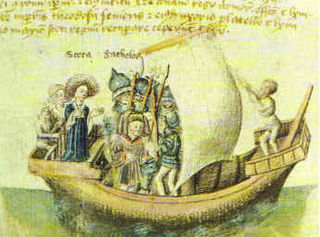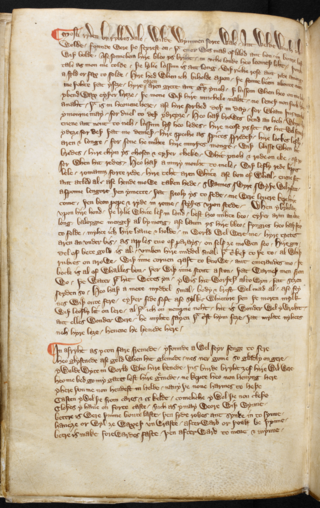| 2. 3. 3a. 3b. 4. 5. 6. 7. | 23ra–33va 33va–39rb 39rb 39va–41va 41va–43vb 43vb–45vb 45vb–47vb 47vb–48vb | AN verse AN prose AN prose AN prose AN prose AN prose AN prose AN prose | Herman de Valenciennes, La Passioun Nostre Seignour De la Passioun Jhesu [L’Évangile de Nicodème] Epistle a Tiberie Epistle a Claudie l’emperour De seint Johan le Ewangeliste De seint Johan le Baptist De seint Bartholomeu Passioun seint Piere | Herman de Valenciennes, The Passion of Our Lord The Gospel of Nicodemus The Letter of Pilate to Tiberias The Letter of Pilate to Emperor Claudius The Life of Saint John the Evangelist The Life of Saint John the Baptist The Life of Saint Bartholomew The Passion of Saint Peter |
| 8. 9. 10. 11. 12. 13. 14. 15. 16. 17. | 49r–50v 51ra–52va 52va 52va 52vb 52vb 52vb 52vb 52vb 52vb | AN verse AN verse ME prose ME prose ME prose ME prose ME prose ME prose ME prose ME prose | ABC a femmes De l’Yver et de l’Esté Vorte make cynople Vorte temprene asure Vorte make gras-grene Vorte maken another maner grene Yet for gaude-grene Vorte couche selverfoyl Vorte maken iren as hart as stel Vorte maken blankplum | ABC of Women Debate between Winter and Summer How to Make Red Vermilion How to Temper Azure How to Make Grass-Green How to Make Another Kind of Green Another for Yellow-Green How to Apply Silverfoil How to Make Iron as Hard as Steel How to Make White Lead |
| 18. 19. 20. 21. 22. 23. 24. 24a. 24a*. 24b. 25. 25a. 26. 27. | 53ra–54vb 54vb 55ra–b 55va–56vb 57r–58v 58v–59r 59r–v 59v 59v 59v 59v–61v 61v 61v–62v 62v | L prose L verse AN verse ME verse ME verse ME verse AN verse AN verse L verse ME verse ME verse ME verse AN verse ME verse | Incipit vita sancti Ethelberti Anima christi, sanctifica me Quant voy la revenue d’yver Alle herkneth to me nou In a thestri stude Y stod Sitteth alle stille ant herkneth to me Chaunter m’estoit Charnel amour est folie Momentaneum est quod delectat Erthe toc of erthe Lystneth, lordynges! A newe song Ichulle bigynne Lord that lenest us lyf Enseignement sur les amis Middelerd for mon wes mad | The Life of Saint Ethelbert Soul of Christ, Sanctify Me A Goliard’s Feast Harrowing of Hell Debate between Body and Soul A Song of Lewes Lament for Simon de Montfort Carnal Love Is Folly What Allures Is Momentary Earth upon Earth The Execution of Sir Simon Fraser On the Follies of Fashion Lesson for True Lovers The Three Foes of Man |
| 28. 29. 30. 31. 32. 33. 34. 35. 36. 37. 38. 39. 40. 41. 43. 44. 45. 46. 47. 48. 49. 50. 51. 52. 53. 54. 55. 56. 57. 58. 59. 60. 61. 62. 63. 64. 65. 66. 67. 68. 69. 70. 71. 72. | 63r–v 63v 63v 64r 64va–65vb 66r 66v 66v–67r 67r 67va–68va 68va–70rb 70rb–v 70va/71ra/71va 70vb/71rb 71va 71vb–72ra 72ra–va 72va–73rb 73r–v 73v–74v 75ra–b 75rb–va 75va–b 75vb 76r 76r 76r 76v–77r 77va 77vb–78va 78vb–79rb 79rb–vb 79vb 80ra 80rb 80v 80v–81r 81r–v 81va–b 82ra–83r 83r 83r–92v 92v–105r 105va–b | ME verse ME verse ME verse ME verse ME verse ME verse ME verse ME verse ME verse AN verse AN prose AN prose ME verse ME verse ME verse ME verse ME verse ME verse ME verse ME verse AN verse ME verse ME verse ME verse ME verse AN verse Trilingual verse AN verse AN verse ME verse AN verse ME verse ME verse ME verse ME verse ME verse ME verse ME verse ME verse ME verse AN & ME verse ME verse AN prose L prose | Ichot a burde in a bour ase beryl so bryht / Annot and John Bytuene Mersh ant Averil / Alysoun With longyng Y am lad Ich herde men upo mold Herketh hideward ant beoth stille Weping haveth myn wonges wet Most I ryden by Rybbesdale In a fryht as Y con fare fremede A wayle whyt ase whalles bon Gilote e Johane Les pelrinages communes que crestiensfountenaSeinteTerre Les pardouns de Acres Ne mai no lewed lued libben in londe Of a mon Matheu thohte Lenten ys come with love to toune In May hit murgeth when hit dawes Heye Louerd, thou here my bone Ichot a burde in boure bryht Alle that beoth of huerte trewe Lustneth, lordinges, bothe yonge ant olde Marie, pur toun enfaunt Suete Jesu, king of blysse Jesu Crist, heovene kyng Wynter wakeneth al my care When Y se blosmes springe Ferroy chaunsoun Dum ludis floribus Quant fu en ma juvente Marie, mere al Salveour Dulcis Jesu memoria Une petite parole Stond wel, moder, under rode Jesu, for thi muchele miht I syke when Y singe Nou skrinketh rose ant lylie-flour My deth Y love, my lyf Ich hate When the nyhtegale singes Blessed be thou, Levedy Ase Y me rod this ender day Herkne to my ron Mayden, moder milde The Geste of Kyng Horn Ludlow Scribe, Estoyres de la Bible Nomina librorum bibliotece | Annot and John Alysoun The Lover’s Complaint Song of the Husbandman The Life of Saint Marina The Poet’s Repentance The Fair Maid of Ribblesdale The Meeting in the Wood A Beauty White as Whale Bone Gilote and Johane Pilgrimages in the Holy Land The Pardons of Acre Satire on the Consistory Court The Laborers in the Vineyard Spring Advice to Women An Old Man’s Prayer Blow, Northern Wind The Death of Edward I The Flemish Insurrection The Joys of Our Lady Sweet Jesus, King of Bliss Jesus Christ, Heaven’s King A Winter Song A Spring Song on the Passion I Pray to God and Saint Thomas While You Play in Flowers Song on Jesus’ Precious Blood Mary, Mother of the Savior Jesus, Sweet Is the Love of You Sermon on God’s Sacrifice and Judgment Stand Well, Mother, under Rood Jesus, by Your Great Might I Sigh When I Sing An Autumn Song The Clerk and the Girl When the Nightingale Sings Blessed Are You, Lady The Five Joys of the Virgin Maximian Maiden, Mother Mild King Horn Ludlow Scribe, Old Testament Stories Names of the Books of the Bible |
| 73 74 75 75a. 76 77 78 79. 80. 81. 82. 83. 84. 85. 86. 87. 88. 89. 90. 91. 92. 93. 94. 95. 96. 97. 98. 99. | 106r 106ra–107rb 107va–109vb 110ra–va 110vb–111rb 111rb–vb 112ra–b 112rc–113vc 113vb–114v 114v–115r 115va–117ra 117ra–118rb 118rb–vb 119ra–121ra 121ra–122va 122vb–124va 124va–125r 125ra–127ra 127rb–va 127va–b 128r 128r–v 128v–129v 129v–130v 131r 131v–132r 132r–133r 133v | ME verse ME verse AN verse AN verse AN verse AN verse AN verse AN verse AN verse ME verse AN verse AN verse AN verse ME verse AN verse AN verse ME verse ME verse ME prose AN prose ME verse ME verse AN prose AN prose AN prose L prose L prose AN & L prose | God that al this myhtes may Lustneth, alle, a lutel throwe Le jongleur d’Ely e le roi d’Angleterre Les trois dames qui troverunt un vit Le dit des femmes Le blasme des femmes Nicholas Bozon, Femmes a la pye Un sage honme de grant valour / Urbain the Courteous Talent me prent de rymer e de geste fere / Trailbaston Mon in the mone stond ant strit Le chevaler e la corbaylle De mal mariage La gagure, ou L’esquier e la chaunbrere A bok of swevenyng Ordre de bel ayse Le chevaler qui fist les cons parler Of rybauds Y ryme ant red o my rolle Mon that wol of wysdam heren When man as mad a kyng of a capped man La destinccioun de la estature Jesu Crist Nostre Seigneur Lutel wot hit any mon hou love hym haveth ybounde Lutel wot hit any mon hou derne love may stonde Enseignements de saint Lewis a Philip soun fitz L’enqueste que le patriarche de Jerusalem fist Les armes des roys Scriptum quod peregrini deferunt Legenda de sancto Etfrido, presbitero de Leoministria Quy chescun jour de bon cuer cest oreisoun dirra | God Who Wields All This Might The Sayings of Saint Bernard The Jongleur of Ely and the King of England The Three Ladies Who Found a Prick The Song on Women The Blame of Women Nicholas Bozon, Women and Magpies Urbain the Courteous Trailbaston The Man in the Moon The Knight and the Basket Against Marriage The Wager, or The Squire and the Chambermaid A Book of Dreaming The Order of Fair Ease The Knight Who Made Vaginas Talk Satire on the Retinues of the Great Hending The Prophecy of Thomas of Erceldoune Distinguishing Features of the Bodily Form of Jesus Christ Our Lord The Way of Christ’s Love The Way of Woman’s Love The Teachings of Saint Louis to His Son Philip The Land of the Saracens Heraldic Arms of Kings Letter for Pilgrims on the Relics at Oviedo The Legend of Saint Etfrid, Priest of Leominster Prayer for Protection |
| 100. 101. 102. 103. 104. 105. 106. 107. 108. 108a. 109. 109a. 110. 111. 112. 113. 114. 115. 116. | 134r 134r 134v 134v 134v–135r 135r 135r 135r 135v 135v 135v–136r 136r 136r–v 136v–137r 137r 137r–v 137v–138v 138v–140r 140v | AN prose AN prose AN verse L prose AN verse & prose L prose AN prose AN prose AN prose AN prose L prose AN prose L prose AN prose L prose L prose AN & L verse AN prose L prose | Quant vous levez le matyn Quy velt que Dieu sovyegne de ly Gloria in excelsis Deo en fraunceis Confiteor tibi, Deus, omnia peccata mea Gloriouse Dame Rex seculorum et Domine dominator Um doit plus volentiers juner le vendredy Quy est en tristour Cely que fra ces messes chaunter Je vous requer, Jaspar, Melchior, e Baltazar Mundus iste totus quoddam scaccarium est Quy chescun jour denz seissaunte jours Contra inimicos si quos habes Seint Hillere archevesque de Peyters ordina ces salmes Eulotropia et celidonia De interrogandi moribundis beati Anselmi Dieu, roy de magesté Contemplacioun de la passioun Jesu Crist De martirio sancti Wistani | Occasions for Angels Occasions for Psalms in AN Glory to God in the Highest in AN Prayer of Confession Prayer on the Five Joys of Our Lady Prayer for Contrition Reasons for Fasting on Friday Seven Masses to Be Said in Misfortune Seven Masses in Honor of God and Saint Giles Prayer to the Three Kings All the World’s a Chess Board Three Prayers That Never Fail Occasions for Psalms in L Occasions for Psalms Ordained by Saint Hilary of Poitiers Heliotrope and Celandine Saint Anselm’s Questions to the Dying Against the King’s Taxes Seven Hours of the Passion of Jesus Christ The Martyrdom of Saint Wistan |








